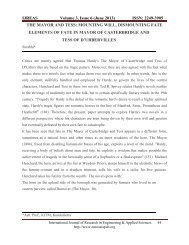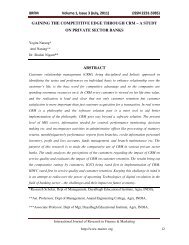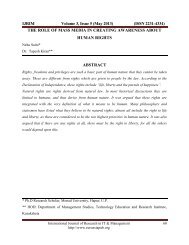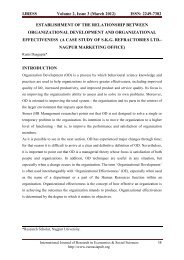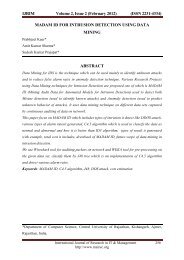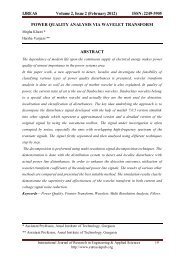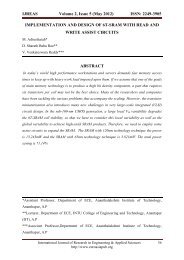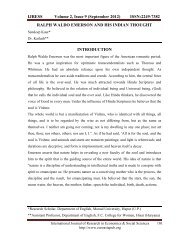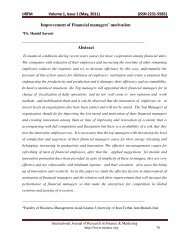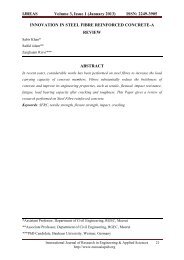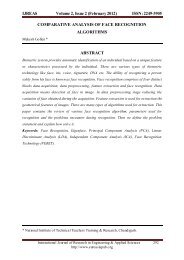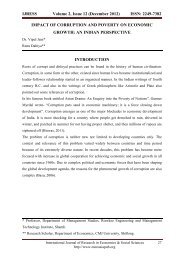scope of biodiesel in india - Euroasiapub.org
scope of biodiesel in india - Euroasiapub.org
scope of biodiesel in india - Euroasiapub.org
You also want an ePaper? Increase the reach of your titles
YUMPU automatically turns print PDFs into web optimized ePapers that Google loves.
IJREAS Volume 2, Issue 8 (August 2012) ISSN: 2249-3905<br />
Prav<strong>in</strong> M. K<strong>in</strong>ge*<br />
Pr<strong>of</strong>. B.R. Kharde**<br />
SCOPE OF BIODIESEL IN INDIA<br />
ABSTRACT<br />
Biodiesel is a hot topic <strong>in</strong>ternationally as well as <strong>in</strong> India. S<strong>in</strong>ce the beg<strong>in</strong>n<strong>in</strong>g <strong>of</strong> the 2000s,<br />
the Government <strong>of</strong> India and, to a greater extent, various state governments have promoted<br />
the production and consumption <strong>of</strong> <strong>biodiesel</strong>. Proponents <strong>of</strong> <strong>biodiesel</strong> po<strong>in</strong>t to the potential <strong>of</strong><br />
oilseeds as a substitute for fossil fuels, underl<strong>in</strong><strong>in</strong>g their ability to reduce India’s energy<br />
dependency and br<strong>in</strong>g down greenhouse gas emissions. They also highlight opportunities for<br />
green<strong>in</strong>g the countryside and creat<strong>in</strong>g rural employment and <strong>in</strong>come. This report shows that<br />
<strong>biodiesel</strong> production <strong>in</strong> India is a special case which has much more positive development<br />
effects than <strong>biodiesel</strong> production elsewhere. India is different because there is far-reach<strong>in</strong>g<br />
consensus there that <strong>biodiesel</strong> production will only be promoted on the basis <strong>of</strong> non-edible oil<br />
seeds on marg<strong>in</strong>al lands. Hence the risks <strong>of</strong> driv<strong>in</strong>g up prices for edible oil or crowd<strong>in</strong>g out<br />
food production are relatively low. In addition, cultivat<strong>in</strong>g tree-borne oilseeds on degraded<br />
lands stabilizes soils and creates carbon s<strong>in</strong>ks, and production requires low <strong>in</strong>puts, which<br />
serves to further improve the carbon balance. Even with<strong>in</strong> India, however, the development<br />
effects <strong>of</strong> the <strong>biodiesel</strong> <strong>in</strong>dustry vary greatly, depend<strong>in</strong>g on how the value cha<strong>in</strong> is <strong>org</strong>anized.<br />
*Lecturer, Mechanical Dept., NIT Polytechnic , Nagpur, M.S., India<br />
**Production Dept., Amrutvah<strong>in</strong> college <strong>of</strong> Engg., Sangamner, M.S. India<br />
International Journal <strong>of</strong> Research <strong>in</strong> Eng<strong>in</strong>eer<strong>in</strong>g & Applied Sciences 1<br />
http://www.euroasiapub.<strong>org</strong>
IJREAS Volume 2, Issue 8 (August 2012) ISSN: 2249-3905<br />
INTRODUCTION<br />
This study identifies no less than 13 different ways <strong>of</strong> <strong>org</strong>aniz<strong>in</strong>g the value cha<strong>in</strong>, rang<strong>in</strong>g<br />
from cultivation on large plantations to contract farm<strong>in</strong>g arrangements, farm-based<br />
production for rural electrification, and social forestry projects. Between these different types<br />
<strong>of</strong> value cha<strong>in</strong>s, there are marked differences <strong>in</strong> terms <strong>of</strong> <strong>in</strong>come generation, participation and<br />
empowerment, food security, natural resources management and climate change, and<br />
economic susta<strong>in</strong>ability.<br />
BIODIESEL IN THE GLOBAL CONTEXT<br />
From 1971 to 2005, the world’s f<strong>in</strong>al consumption <strong>of</strong> oil rose from about 2000 million<br />
tonnes/year to almost 3500 million tonnes/year. correspond<strong>in</strong>gly, the price for crude oil on<br />
the world market went up from 20 US$/barrel <strong>in</strong> the 1990s to over 145 US$/barrel <strong>in</strong> July<br />
2008. Although prices fell below 100 US$/barrel aga<strong>in</strong> <strong>in</strong> October, when this study was<br />
f<strong>in</strong>alized, most analysts expect higher oil prices <strong>in</strong> the long term. In view <strong>of</strong> ris<strong>in</strong>g prices and<br />
the environmental – and primarily climate-change – concerns that result from <strong>in</strong>creased<br />
global energy consumption, countries all over the world have launched bi<strong>of</strong>uel programmes<br />
to develop alternatives to conventional fuels. While the share <strong>of</strong> bi<strong>of</strong>uels <strong>in</strong> overall global<br />
fuel consumption was still marg<strong>in</strong>al <strong>in</strong> 2006 (less than 1 %), the growth rate <strong>of</strong> bi<strong>of</strong>uel<br />
production is enormous. Between 2000 and 2005, worldwide production <strong>of</strong> bioethanol rose<br />
by 95 % and <strong>biodiesel</strong> output even grew by 295 %. 1 Bioethanol and <strong>biodiesel</strong> need to be<br />
dist<strong>in</strong>guished when we speak <strong>of</strong> liquid bi<strong>of</strong>uels.2 Bioethanol is derived from starch and sugar,<br />
mak<strong>in</strong>g maize and sugar cane – or the waste products produced dur<strong>in</strong>g their process<strong>in</strong>g – the<br />
most important feedstock used for its production. In contrast, <strong>biodiesel</strong> is obta<strong>in</strong>ed from any<br />
k<strong>in</strong>d <strong>of</strong> vegetable oil like rapeseed, soybean, palm or sunflower oil, for example. With 28.3<br />
billion litres, global production <strong>of</strong> ethanol is about six times as high as <strong>biodiesel</strong> production<br />
and therefore more relevant on the global scale. Demand for bi<strong>of</strong>uel is ris<strong>in</strong>g especially due to<br />
mandatory blend<strong>in</strong>g requirements adopted by large energy consumer countries. In order to<br />
contribute to energy security and to abide by the requirements <strong>of</strong> the Kyoto protocol, many<br />
have developed ambitious plans to further substitute bi<strong>of</strong>uel for fossil fuel. In 2003, for<br />
example, the EU set targets for blend<strong>in</strong>g bi<strong>of</strong>uel <strong>in</strong> the transport sector at a rate <strong>of</strong> 2 % by<br />
2005 and 5.75 % by 2010. In addition, several European countries support the use <strong>of</strong> bi<strong>of</strong>uels<br />
through tax reductions or higher 1 The driv<strong>in</strong>g countries <strong>in</strong> bioethanol production are ma<strong>in</strong>ly<br />
Brazil and the United States, while especially Germany and France are engaged <strong>in</strong> produc<strong>in</strong>g<br />
<strong>biodiesel</strong>. Germany, with a share <strong>of</strong> about 40 %, is the world’s largest <strong>biodiesel</strong> producer<br />
International Journal <strong>of</strong> Research <strong>in</strong> Eng<strong>in</strong>eer<strong>in</strong>g & Applied Sciences 2<br />
http://www.euroasiapub.<strong>org</strong>
IJREAS Volume 2, Issue 8 (August 2012) ISSN: 2249-3905<br />
(Worldwatch Institute 2007, 7). 2 S<strong>in</strong>ce any k<strong>in</strong>d <strong>of</strong> motor or generator can also be designed<br />
to run on gas, gas can also be considered a fuel <strong>in</strong> a broader sense. This study, however, only<br />
refers to bioethanol and <strong>biodiesel</strong> when it speaks <strong>of</strong> bi<strong>of</strong>uels. Tilman Altenburg et al. 14<br />
German Development Institute blend<strong>in</strong>g requirements (Worldwatch Institute 2007, 283 ff.).<br />
The United States set – <strong>in</strong> the Energy Policy Act <strong>of</strong> 2005 – the target <strong>of</strong> blend<strong>in</strong>g 28.4 billion<br />
litres <strong>of</strong> bi<strong>of</strong>uel by 2012. It is estimated that these measures will create demand for an<br />
additional 9.2 million tonnes <strong>of</strong> bi<strong>of</strong>uel worldwide (ibid., 9). The <strong>in</strong>ternational public debate<br />
on bi<strong>of</strong>uel, though, has shifted from euphoria to <strong>in</strong>creas<strong>in</strong>gly critical and sceptical voices. In<br />
this sense, the OECD asks <strong>in</strong> a discussion paper on bi<strong>of</strong>uels whether “the cure is worse than<br />
the disease” (Doornbosch / Steenblik 2007). The criticism ma<strong>in</strong>ly regards two aspects: a)<br />
concerns about the impact <strong>of</strong> bi<strong>of</strong>uel production on food security, and b) doubts about the<br />
overall positive net carbon balance <strong>of</strong> those fuels. Both po<strong>in</strong>ts <strong>of</strong> criticism will be discussed<br />
briefly <strong>in</strong> the follow<strong>in</strong>g. With regard to worldwide food security, two questions arise about<br />
the effects <strong>of</strong> bi<strong>of</strong>uels: First, it is unclear how big the impact <strong>of</strong> bi<strong>of</strong>uel production is on the<br />
rise <strong>of</strong> food prices. Second, it is disputed whether a rise <strong>in</strong> food prices <strong>in</strong>creases or decreases<br />
food security, especially <strong>of</strong> the world’s poor. The fact is that food prices have been ris<strong>in</strong>g,<br />
especially <strong>in</strong> the last few years. There are three reasons why bi<strong>of</strong>uel production has some<br />
k<strong>in</strong>d <strong>of</strong> impact on this rise <strong>of</strong> food prices. First, the raw material used for bi<strong>of</strong>uel production –<br />
ma<strong>in</strong>ly maize, sugar cane, rapeseed and palm oil – does not enter the food market, and<br />
therefore food supply is reduced.<br />
BIODIESEL IN INDIA<br />
The Indian <strong>biodiesel</strong> sector is different from bi<strong>of</strong>uel activities <strong>in</strong> many other countries <strong>of</strong> the<br />
world because it is based on the use <strong>of</strong> non-edible oils derived from oil-bear<strong>in</strong>g trees that can<br />
grow on less fertile land. This renders it more positive because risks <strong>of</strong> food crop replacement<br />
can be avoided, many small farmers and landless cultivators can generate additional <strong>in</strong>come<br />
and the plants can serve for green<strong>in</strong>g barren lands.Tilman Altenburg et al. 18 German<br />
Development Institute This study focuses exclusively on <strong>biodiesel</strong> programmes <strong>in</strong> India.<br />
While the country is already the world’s 7th largest ethanol producer, with an annual<br />
production <strong>of</strong> 200 million litres <strong>of</strong> ethanol (Worldwatch Institute 2007, 6), <strong>biodiesel</strong><br />
production started only a few years ago. The follow<strong>in</strong>g chapter portrays the <strong>biodiesel</strong> sector.<br />
Chapter 3.1 first describes the <strong>biodiesel</strong> value cha<strong>in</strong> <strong>in</strong> India, lay<strong>in</strong>g special emphasis on the<br />
feedstock and – result<strong>in</strong>g from this – the type <strong>of</strong> land needed for production. The potentials<br />
for development will be depicted <strong>in</strong> Chapter 3.2. These are manifold, but certa<strong>in</strong> risks rema<strong>in</strong><br />
International Journal <strong>of</strong> Research <strong>in</strong> Eng<strong>in</strong>eer<strong>in</strong>g & Applied Sciences 3<br />
http://www.euroasiapub.<strong>org</strong>
IJREAS Volume 2, Issue 8 (August 2012) ISSN: 2249-3905<br />
that food crops may be displaced. However, the <strong>biodiesel</strong> sector <strong>in</strong> India is still <strong>in</strong> a nascent<br />
state, which is ma<strong>in</strong>ly due to a lack <strong>of</strong> economic viability for almost all activities related to<br />
the sector. Reasons for this general barrier to the development <strong>of</strong> <strong>biodiesel</strong> production <strong>in</strong><br />
India will be specified <strong>in</strong> Chapter 3.3. 3.1 The <strong>biodiesel</strong> value cha<strong>in</strong> <strong>in</strong> India The follow<strong>in</strong>g<br />
chapter describes some general aspects <strong>of</strong> the <strong>biodiesel</strong> value cha<strong>in</strong> <strong>in</strong> India. This will help to<br />
better understand and assess the developmental impacts <strong>of</strong> <strong>biodiesel</strong> production and<br />
consumption. For example, at the cultivation stage the type <strong>of</strong> land and type <strong>of</strong> plantation<br />
have important impacts on socioeconomic and environmental effects. Different ways <strong>of</strong><br />
process<strong>in</strong>g the raw material imply different cost structures and require different technical<br />
capacities. Not all <strong>of</strong> them are suitable for the same conditions. Different end-products are<br />
consumed by different people at different levels – local or more distant – and have different<br />
developmental impacts. Moreover, the use <strong>of</strong> by-products allows people to earn additional<br />
<strong>in</strong>come. As not all crops generate the same by-products, some crops may be more<br />
economically viable than others. The chapter is divided <strong>in</strong>to separate sections on the three<br />
steps <strong>of</strong> the value cha<strong>in</strong> – cultivation, process<strong>in</strong>g, and consumption – and a last section on<br />
different alternate uses and by-products <strong>of</strong> straight vegetable oil (SVO) and <strong>biodiesel</strong> that<br />
may generate additional <strong>in</strong>come sources. The follow<strong>in</strong>g figure presents the simplified value<br />
cha<strong>in</strong> <strong>of</strong> <strong>biodiesel</strong> <strong>in</strong> India. It breaks down <strong>in</strong>to three steps: cultivation, process<strong>in</strong>g, and<br />
consumption.<br />
Cultivation<br />
SVO, the raw material for <strong>biodiesel</strong>, can be extracted from many different plants. Seeds <strong>of</strong><br />
certa<strong>in</strong> plants (e.g. rapeseed, soya, sunflowers) have a high oil content and are, <strong>in</strong> some<br />
countries, used for <strong>biodiesel</strong> production. In India, SVO is derived almost exclusively from<br />
oil-bear<strong>in</strong>g trees. Several tree species can be selected for <strong>biodiesel</strong> production. More than 300<br />
different species <strong>of</strong> oil-bear<strong>in</strong>g trees exist <strong>in</strong> India. All <strong>of</strong> them are naturally grow<strong>in</strong>g wild<br />
species that have not yet been cultivated and harvested systematically for oil production on a<br />
larger scale.4 Some <strong>of</strong> the seeds have been traditionally collected by poor people for light<strong>in</strong>g.<br />
In small quantities, TBOs are used for commercial purposes <strong>in</strong> the pa<strong>in</strong>t, lubricant and soap<br />
<strong>in</strong>dustries. Accord<strong>in</strong>g to the National Oilseeds and Vegetable Oils Development Board <strong>of</strong> the<br />
Indian M<strong>in</strong>istry <strong>of</strong> Agriculture (NOVOD s.a.[d]) there are about ten species with economic<br />
potential for <strong>biodiesel</strong> production, <strong>in</strong>clud<strong>in</strong>g Jatropha curcas, Pongamia p<strong>in</strong>nata, Simarouba<br />
glauca,5 Azadirachta <strong>in</strong>dica (Neem) and Madhuca <strong>in</strong>dica (Mahua). Proponents <strong>of</strong> <strong>biodiesel</strong> <strong>in</strong><br />
India focus almost exclusively on Jatropha and to a lesser extent on Pongamia. Other species<br />
have not received much attention. The focus on Jatropha is justified ma<strong>in</strong>ly on the basis <strong>of</strong><br />
International Journal <strong>of</strong> Research <strong>in</strong> Eng<strong>in</strong>eer<strong>in</strong>g & Applied Sciences 4<br />
http://www.euroasiapub.<strong>org</strong>
IJREAS Volume 2, Issue 8 (August 2012) ISSN: 2249-3905<br />
two arguments: First <strong>of</strong> all, Jatropha is a shrub, i.e. it does not grow <strong>in</strong>to a tree. Therefore, it<br />
is easier to harvest than large trees and has a much shorter gestation period. S<strong>in</strong>ce the time<br />
span between <strong>in</strong>vestment and return is shorter, more people could be will<strong>in</strong>g to start<br />
cultivat<strong>in</strong>g this crop. Second, the seed collection period <strong>of</strong> Jatropha does not co<strong>in</strong>cide with<br />
the ra<strong>in</strong>y season <strong>in</strong> June-July, when most agricultural activities take place. This makes it<br />
possible for people to generate additional <strong>in</strong>come <strong>in</strong> the slack agricultural season (Negi et al.<br />
2006, 34). Pongamia has become the second most important feedstock <strong>of</strong> the Indian <strong>biodiesel</strong><br />
sector for the reason that this tree is tradition- 4 It is estimated that only 10 % <strong>of</strong> the seeds<br />
from natural plantations are been collected (Ghasias 2006, 217). 5 Simarouba glauca is a<br />
promis<strong>in</strong>g oil-bear<strong>in</strong>g tree, which was only recently <strong>in</strong>troduced <strong>in</strong> India. Simarouba oil is<br />
edible, but its consumption for cook<strong>in</strong>g is not habitual <strong>in</strong> India (Joshi / Joshi 2007, 99 ff.).<br />
Therefore, the tree is promoted for the production <strong>of</strong> <strong>biodiesel</strong> by some supporters, although<br />
the general Indian consensus is not to use edible oil for fuel production. Biodiesel <strong>in</strong> India<br />
German Development Institute 21 ally planted <strong>in</strong> several states and therefore well known to<br />
people. Be<strong>in</strong>g a multipurpose plant that is a source not only <strong>of</strong> oil but also <strong>of</strong> animal feed,<br />
manure, fire wood and substances with medic<strong>in</strong>al uses, farmers already <strong>in</strong>tegrate Pongamia<br />
<strong>in</strong>to their farm<strong>in</strong>g systems. Pongamia is also systematically planted on public land such as<br />
forests or along roads, and it already is common practice for people to collect and sell the<br />
seeds – provided they f<strong>in</strong>d a market (Int. Ramakrishna, Samagra Vikas). The most important<br />
characteristic that dist<strong>in</strong>guishes oil-bear<strong>in</strong>g trees from other cash crops is the fact that they<br />
require very few nutrients to survive and therefore can also be grown on less fertile land. To<br />
survive, Jatropha, for example, only needs a m<strong>in</strong>imum <strong>of</strong> around 600 mm <strong>of</strong> ra<strong>in</strong>fall per year<br />
and temperatures that do not go below about 3°C (GTZ / TERI 2007, 7; Jongschaap et al.<br />
2007, 18). However, it is an <strong>in</strong>put-respond<strong>in</strong>g plant, mean<strong>in</strong>g that fertile land, fertiliser and<br />
pesticides as well as better irrigation will lead to much higher oilseed yields (Jongschaap et<br />
al. 2007, 15- 16). Under favourable conditions, a yield <strong>of</strong> up to 2.5 kg/plant can be achieved<br />
There are three ways <strong>of</strong> cultivat<strong>in</strong>g oil-bear<strong>in</strong>g trees. First, they can be grown as boundary<br />
plantation, e.g. around fields or along roads, railways and canals. Second, they can be planted<br />
<strong>in</strong> monoculture as block plantations. Third, oil-bear<strong>in</strong>g trees can be cultivated through <strong>in</strong>tercropp<strong>in</strong>g<br />
with other species, which is likely to happen when it is used for afforestation, but<br />
also possible when it is grown on fields. Boundary plantations <strong>of</strong> oil-bear<strong>in</strong>g trees, especially<br />
<strong>of</strong> Jatropha and Pongamia are already common <strong>in</strong> India, even if the seeds are not used for<br />
SVO or <strong>biodiesel</strong> production. There rema<strong>in</strong>s a certa<strong>in</strong> range up to which this k<strong>in</strong>d <strong>of</strong><br />
cultivation can be extended, but the amount <strong>of</strong> oilseeds produced will still rema<strong>in</strong> marg<strong>in</strong>al<br />
International Journal <strong>of</strong> Research <strong>in</strong> Eng<strong>in</strong>eer<strong>in</strong>g & Applied Sciences 5<br />
http://www.euroasiapub.<strong>org</strong>
IJREAS Volume 2, Issue 8 (August 2012) ISSN: 2249-3905<br />
compared to the amount that could be reached through cultivation on regular plantations,<br />
either through monoculture or <strong>in</strong>ter-cropp<strong>in</strong>g. These plantations can, <strong>in</strong> turn, be set up on<br />
three types <strong>of</strong> land: regular agricultural land, regular forestland as well as un- or underutilised<br />
land (<strong>of</strong>ten called “wasteland”). The first possibility, plantations on regular fertile agricultural<br />
lands, implies competition with other crops that can also be grown here. In India, most<br />
farmers are not will<strong>in</strong>g to plant oil-bear<strong>in</strong>g trees on fertile lands because yields and prices are<br />
considerably lower than those <strong>of</strong> food crops such as rice, wheat or sugar at this po<strong>in</strong>t <strong>in</strong> time.<br />
Chang<strong>in</strong>g cultivation patterns on already used fertile agricultural lands will only take place if<br />
the revenues from the cultivation <strong>of</strong> oil-bear<strong>in</strong>g trees exceed those from food crops, which<br />
would presuppose either considerably higher demand (e.g. through higher prices <strong>of</strong><br />
conventional fuel) or extraord<strong>in</strong>ary <strong>in</strong>creases <strong>in</strong> productivity The second possibility, to grow<br />
oil-bear<strong>in</strong>g trees on forest land, ma<strong>in</strong>ly refers to afforestation. Regenerat<strong>in</strong>g degraded forest<br />
areas for ecological reasons and susta<strong>in</strong>able use <strong>of</strong> resources is desired <strong>in</strong> many forest<br />
regions <strong>of</strong> India. Pongamia – like any other tree – can serve this purpose very well. Jatropha,<br />
<strong>in</strong> contrast, is a shrub rather than a tree and it is therefore less useful for afforestation. India<br />
strongly promotes jo<strong>in</strong>t forest management (JFM) programmes <strong>in</strong> order to comb<strong>in</strong>e the<br />
benefits <strong>of</strong> afforestation and <strong>in</strong>come generation for lower casts and tribal people . The third<br />
possibility – and the one most favoured <strong>in</strong> the public discussion <strong>in</strong> India – is the use <strong>of</strong> un- or<br />
underutilised land for cultivation <strong>of</strong> oil-bear<strong>in</strong>g trees. Such land that is not suitable for any<br />
other crop because <strong>of</strong> its low fertility is called “wasteland” <strong>in</strong> day-to-day parlance. The<br />
Wastelands Atlas <strong>of</strong> India, a satellite-based land survey by the Indian M<strong>in</strong>istry <strong>of</strong> Rural<br />
Development, identifies 553,000 km² <strong>of</strong> the 3.3 million km² <strong>of</strong> total land area <strong>in</strong> India as<br />
wasteland (MoRD 2005, 12). Considerable parts <strong>of</strong> India’s degraded forest land (108,000<br />
km²), land with scrub vegetation (151,000 km², ibid.) – together amount<strong>in</strong>g to more than 8 %<br />
<strong>of</strong> the total geographic area <strong>in</strong> India – as well as certa<strong>in</strong> other lands6 could serve for<br />
plantations <strong>of</strong> oil-bear<strong>in</strong>g trees. Although more recently, the Government <strong>of</strong> India reduced its<br />
estimate <strong>of</strong> land reserves that are suitable for bi<strong>of</strong>uel crop cultivation to 72,000 km², even this<br />
potential is enormous (Shankar 2006, 94). More drought-resistant than most other crops, oilbear<strong>in</strong>g<br />
trees can contribute to the rehabilitation <strong>of</strong> unutilised land by stabiliz<strong>in</strong>g soil,<br />
improv<strong>in</strong>g manure cover and br<strong>in</strong>g<strong>in</strong>g degraded land back <strong>in</strong>to productive use.<br />
However, the term wrongly suggests that all <strong>of</strong> this land lies waste and is not used by<br />
anybody. In reality, even unsuitable degraded land is still <strong>of</strong>ten used illegally by the poorest<br />
parts <strong>of</strong> the population for subsistence agricultural production or – even more commonly –<br />
for cattle husbandry. Claims <strong>of</strong> 13.4 million ha <strong>of</strong> available land for TBO cultivation<br />
International Journal <strong>of</strong> Research <strong>in</strong> Eng<strong>in</strong>eer<strong>in</strong>g & Applied Sciences 6<br />
http://www.euroasiapub.<strong>org</strong>
IJREAS Volume 2, Issue 8 (August 2012) ISSN: 2249-3905<br />
(Plann<strong>in</strong>g Commission 2003) therefore need to be looked at with care. Br<strong>in</strong>g<strong>in</strong>g much <strong>of</strong> this<br />
land under Jatropha or Pongamia plantation would certa<strong>in</strong>ly imply the displacement <strong>of</strong><br />
marg<strong>in</strong>alised groups <strong>of</strong> the population.<br />
Process<strong>in</strong>g<br />
Once the fruits have been harvested, the first step <strong>in</strong> process<strong>in</strong>g is extract<strong>in</strong>g the oil. Only the<br />
seed <strong>of</strong> the fruit conta<strong>in</strong>s oil, so it is necessary first to separate the seed from the fruit hull.<br />
The seed itself also consists <strong>of</strong> a shell and a kernel. Before the oil is expelled, it is more<br />
efficient to remove the seed shell from the kernel <strong>in</strong> order to improve the extracted SVO. If<br />
this is not done, sediments <strong>of</strong> the shell will rema<strong>in</strong> <strong>in</strong> the SVO. After hull<strong>in</strong>g, the kernels are<br />
ground. There are two methods <strong>of</strong> extract<strong>in</strong>g the oil from the ground kernels. First, the<br />
kernels can be pressed, us<strong>in</strong>g hand-powered press<strong>in</strong>g mach<strong>in</strong>es or mechanized equipment.<br />
When small-scale hand-powered press<strong>in</strong>g mach<strong>in</strong>es are used, only around 60 % <strong>of</strong> the total<br />
extractable oil can be expelled. More mechanized expellers such as animal-powered so-called<br />
ghanis can expel about 75 % <strong>of</strong> the oil content. Further advanced press<strong>in</strong>g mach<strong>in</strong>ery can<br />
obta<strong>in</strong> up to 90 % <strong>of</strong> the 6 Other relevant categories <strong>of</strong> wastelands with potentials for the<br />
cultivation <strong>of</strong> oil-bear<strong>in</strong>g trees <strong>in</strong>clude 37,000 km² <strong>of</strong> land without scrub, 16,000 km² <strong>of</strong><br />
shallow/moderately gullied or ravenous land and 9,000 km² <strong>of</strong> land with slight or moderate<br />
sal<strong>in</strong>e or alkal<strong>in</strong>e values (MoRD 2005, 12; Shankar 2006, 94). Tilman Altenburg et al.<br />
extractable oil. Second, the more efficient way to expel the oil from the kernel is to use a<br />
chemical solvent that can extract almost 100 % <strong>of</strong> the oil (Jongschaap et al. 2007). This<br />
requires a highly sophisticated <strong>in</strong>dustrial oil extraction process, s<strong>in</strong>ce the solvent needs to be<br />
handled with care and also must be removed from the oil after process<strong>in</strong>g. The two methods,<br />
press<strong>in</strong>g and solvent extraction, can also be comb<strong>in</strong>ed. The second step <strong>in</strong> process<strong>in</strong>g is the<br />
transformation <strong>of</strong> SVO <strong>in</strong>to <strong>biodiesel</strong>. This process is called transesterification. Depend<strong>in</strong>g on<br />
the f<strong>in</strong>al use <strong>of</strong> the fuel, transesterification may prove worthwhile. Transesterification<br />
requires three raw materials: SVO, alcohol (usually methanol is used), and an alkal<strong>in</strong>e<br />
catalyst (e.g. sodium or potassium hydroxide). A two-stage chemical reaction first separates<br />
the SVO <strong>in</strong>to free fatty acids and glycerol and then merges the free fatty acids with the<br />
methanol, generat<strong>in</strong>g fatty acid methyl ester, which is the chemical term for <strong>biodiesel</strong>. The<br />
glycerol rema<strong>in</strong>s as a by-product <strong>of</strong> the procedure. Transesterification units can have a large<br />
range <strong>of</strong> process<strong>in</strong>g capacities, from small-scale <strong>biodiesel</strong> units to largescale<br />
transesterification plants. Handl<strong>in</strong>g and storage <strong>of</strong> <strong>biodiesel</strong>, however, require certa<strong>in</strong><br />
pr<strong>of</strong>essionalism, s<strong>in</strong>ce it is toxic and <strong>in</strong>flammable.<br />
International Journal <strong>of</strong> Research <strong>in</strong> Eng<strong>in</strong>eer<strong>in</strong>g & Applied Sciences 7<br />
http://www.euroasiapub.<strong>org</strong>
IJREAS Volume 2, Issue 8 (August 2012) ISSN: 2249-3905<br />
Consumption<br />
Both SVO and <strong>biodiesel</strong> are suitable for f<strong>in</strong>al consumption. SVO can be used for light<strong>in</strong>g<br />
(replac<strong>in</strong>g petroleum <strong>in</strong> lamps) and cook<strong>in</strong>g (<strong>in</strong> specially designed cook<strong>in</strong>g stoves). It can<br />
also replace conventional diesel <strong>in</strong> eng<strong>in</strong>es (e.g. electricity<br />
generators or water pumps). S<strong>in</strong>ce SVO has very high viscosity, however, fuel <strong>in</strong>jection<br />
pumps need to be modified, otherwise eng<strong>in</strong>es will abrade much faster. Hence, operational<br />
and ma<strong>in</strong>tenance costs <strong>of</strong> eng<strong>in</strong>es runn<strong>in</strong>g on SVO are higher than for those runn<strong>in</strong>g on<br />
conventional diesel. The fuel properties <strong>of</strong> <strong>biodiesel</strong>, on the other hand, are a lot better than<br />
those <strong>of</strong> SVO. Thus, replac<strong>in</strong>g diesel with <strong>biodiesel</strong> <strong>in</strong>stead <strong>of</strong> SVO reduces operational and<br />
ma<strong>in</strong>tenance costs. Some projects aim<strong>in</strong>g at rural energy security use SVO for their mach<strong>in</strong>es<br />
and electricity generators, while others first transesterificate and use <strong>biodiesel</strong> for the same<br />
purposes. The advantages <strong>of</strong> the latter are better fuel properties, lead<strong>in</strong>g to more efficient fuel<br />
combustion and less pollution. There are, however, economic and safety issues associated<br />
with the process <strong>of</strong> transesterification. Additional technology and equipment as well as other<br />
<strong>in</strong>puts (methanol, catalyst) are needed to process SVO <strong>in</strong>to <strong>biodiesel</strong>. This means additional<br />
costs both for <strong>in</strong>vestment and ma<strong>in</strong>tenance. Also, qualified personBiodiesel <strong>in</strong> India nel has<br />
to be tra<strong>in</strong>ed to operate the complicated transesterification process. These issues, however,<br />
could be resolved with careful plann<strong>in</strong>g and implementation. One solution to this problem <strong>of</strong><br />
viscosity is to blend diesel with either SVO or <strong>biodiesel</strong>. An SVO-diesel blend, though, still<br />
requires a modification <strong>of</strong> the eng<strong>in</strong>e for proper function<strong>in</strong>g <strong>in</strong> most cases. The characteristics<br />
<strong>of</strong> the SVO may vary a lot due to differences <strong>in</strong> seed quality and extraction methods.<br />
Therefore, the percentage up to which a blend<strong>in</strong>g <strong>of</strong> diesel with SVO is possible depends <strong>in</strong><br />
large measure on SVO quality and eng<strong>in</strong>e type. By contrast, the characteristics <strong>of</strong> <strong>biodiesel</strong><br />
are rather consistent because <strong>of</strong> the standardized chemical reaction processes dur<strong>in</strong>g<br />
transesterification. Blend<strong>in</strong>g diesel with <strong>biodiesel</strong> is therefore much more efficient.<br />
Depend<strong>in</strong>g on the study consulted, blend<strong>in</strong>g <strong>of</strong> up to 50 % is possible without any major<br />
operational difficulties for eng<strong>in</strong>es (Jongschaap et al. 2007, 15). By-products and alternate<br />
uses <strong>of</strong> SVO and <strong>biodiesel</strong> Several by-products have economic value. Oil-bear<strong>in</strong>g trees not<br />
only produce seeds/fruits, their leaves, latex and wood can also be used. Leaves <strong>of</strong> some<br />
oilbear<strong>in</strong>g trees can serve as valuable <strong>org</strong>anic fertiliser,7 and both leaves and latex <strong>of</strong> some<br />
species are used for medic<strong>in</strong>al purposes. When trees or bushes are pruned, branches can be<br />
used as firewood or – like any other biomass – for biogas production. Furthermore, fruit hulls<br />
may serve for all the possible uses mentioned above – as <strong>org</strong>anic fertiliser, for burn<strong>in</strong>g, for<br />
medic<strong>in</strong>al purposes as well as for biogas production. Two other important by-products <strong>of</strong><br />
International Journal <strong>of</strong> Research <strong>in</strong> Eng<strong>in</strong>eer<strong>in</strong>g & Applied Sciences 8<br />
http://www.euroasiapub.<strong>org</strong>
IJREAS Volume 2, Issue 8 (August 2012) ISSN: 2249-3905<br />
SVO/<strong>biodiesel</strong> production emerge dur<strong>in</strong>g further process<strong>in</strong>g: seed cake and glycerol. After<br />
the oil is extracted, what rema<strong>in</strong>s is the particulate material <strong>of</strong> the kernel, which is called seed<br />
cake. It can be used as an <strong>org</strong>anic fertiliser. S<strong>in</strong>ce yields <strong>in</strong>crease substantially when fertiliser<br />
is applied, the seed cake can be taken back to the field and used to facilitate cultivation. In<br />
addition, it is also possible to produce biogas from the seed cake. Theoretically, seed cake<br />
could also serve as fodder for animals. However, Jatropha seedcake has to be detoxified, and<br />
detoxification has proven successful only <strong>in</strong> the lab (Jongschaap et al. 7 In the case <strong>of</strong><br />
Jatropha, the leaves have toxic properties and its effects on soil fertility have not yet been<br />
properly researched. The process – if applied <strong>in</strong> the field – would currently be very<br />
expensive, so that Jatropha seed cake as fodder would not be able to hold its own <strong>in</strong> the<br />
market. Glycerol (glycer<strong>in</strong>e) is removed from the SVO dur<strong>in</strong>g transesterification. It is an<br />
important <strong>in</strong>gredient for many k<strong>in</strong>ds <strong>of</strong> cosmetics, soaps and pharmaceutical products. If the<br />
market demand for glycerol is high and the by-product can be sold at a good price, <strong>biodiesel</strong><br />
production can become a lot more cost-efficient. However, this is not an important issue <strong>in</strong><br />
India (yet). Dur<strong>in</strong>g the course <strong>of</strong> the field research for this study, glycerol did not play a role<br />
<strong>in</strong> any <strong>of</strong> the cases exam<strong>in</strong>ed. Compared to the various by-products, the opportunities for<br />
alternate uses <strong>of</strong> SVO or <strong>biodiesel</strong> are very limited. The s<strong>in</strong>gle most important mode <strong>of</strong><br />
consumption is use as some k<strong>in</strong>d <strong>of</strong> fuel. Biodiesel, <strong>in</strong> fact, can only serve as “petrol.” On the<br />
other hand, some SVO can – depend<strong>in</strong>g on the plant <strong>of</strong> orig<strong>in</strong> – be consumed as food, but<br />
Jatropha and Pongamia-based SVO is non-edible. One alternate use <strong>of</strong> the oil, however, is for<br />
soap production. A soap <strong>of</strong> good quality is produced from Jatropha-based SVO, <strong>in</strong> some<br />
countries (e.g. <strong>in</strong> Mali and Haiti). Some projects promote this k<strong>in</strong>d <strong>of</strong> process<strong>in</strong>g <strong>in</strong> order to<br />
generate <strong>in</strong>come for poor rural families. In India, however, the production <strong>of</strong> soap from treeborne<br />
oilseeds is not common.<br />
BIODIESEL POLICIES IN INDIA<br />
The follow<strong>in</strong>g chapter gives an overview <strong>of</strong> Indian <strong>biodiesel</strong> policies at the central and state<br />
level. We use the term “<strong>biodiesel</strong> policies” <strong>in</strong> a broad sense, <strong>in</strong>clud<strong>in</strong>g comprehensive policy<br />
<strong>in</strong>itiatives that are explicitly framed as ‘<strong>biodiesel</strong> policy’ as well as programmes that are <strong>of</strong> a<br />
general nature but may be used to promote <strong>biodiesel</strong>, such as afforestation and rural<br />
employment programmes. The first part <strong>of</strong> the chapter discusses the rationale for policymakers<br />
to <strong>in</strong>tervene <strong>in</strong> the <strong>biodiesel</strong> market. It shows that market failures are relevant and<br />
justify government support <strong>in</strong> pr<strong>in</strong>ciple. However, India’s government has a long history <strong>of</strong><br />
overregulation <strong>of</strong> the economy. Until the late 1980s, distorted <strong>in</strong>centives and red tape<br />
International Journal <strong>of</strong> Research <strong>in</strong> Eng<strong>in</strong>eer<strong>in</strong>g & Applied Sciences 9<br />
http://www.euroasiapub.<strong>org</strong>
IJREAS Volume 2, Issue 8 (August 2012) ISSN: 2249-3905<br />
hampered <strong>in</strong>vestment and productivity growth. Aga<strong>in</strong>st this background, several policy<br />
reforms and rema<strong>in</strong><strong>in</strong>g weaknesses (e.g. related to rural development, forest management,<br />
and decentralization) are addressed that are directly related to the <strong>biodiesel</strong> <strong>in</strong>dustry.<br />
Follow<strong>in</strong>g 21 One successful example for improv<strong>in</strong>g the productivity <strong>of</strong> plant material<br />
through R&D is the mycorrhiza technology developed by TERI. Apply<strong>in</strong>g this fungus to the<br />
roots <strong>of</strong> Jatropha shortens the gestations period and <strong>in</strong>creases yields by up to 30 % (Adholeya<br />
/ S<strong>in</strong>gh 2006, 144).<br />
Rationale for policy <strong>in</strong>tervention<br />
As the previous chapters have shown, <strong>biodiesel</strong> bears strong potentials – but also risks – with<br />
regard to India’s simultaneous challenges <strong>of</strong> energy security, climate change mitigation, and<br />
rural development. Despite its potentials, a <strong>biodiesel</strong> market has not yet fully developed <strong>in</strong><br />
India. This is due to a series <strong>of</strong> market failures. Biodiesel cannot yet compete with fossil<br />
fuels, as the prices <strong>of</strong> the latter do not reflect the negative environmental externalities which<br />
they cause. If these costs were <strong>in</strong>ternalised, <strong>biodiesel</strong> would be more competitive as it causes<br />
far lower environmental costs. At the same time, positive externalities <strong>of</strong> R&D efforts <strong>in</strong><br />
<strong>biodiesel</strong> and <strong>of</strong> processes <strong>of</strong> self-discovery cannot be fully appropriated by <strong>in</strong>vestors and<br />
farmers. The vast part <strong>of</strong> this knowledge will consist <strong>in</strong> nonpatentable <strong>in</strong>cremental<br />
<strong>in</strong>novations that can be freely appropriated by anyone. The same applies for the positive<br />
social externalities which <strong>biodiesel</strong> production may imply for rural development. A number<br />
<strong>of</strong> market failures specifically prevent the poor <strong>in</strong> remote areas from benefit<strong>in</strong>g from the<br />
opportunities <strong>of</strong> the sector. Most importantly, s<strong>in</strong>ce TBObased <strong>biodiesel</strong> production is a new<br />
activity, poor potential cultivators lack <strong>in</strong>formation about cultivation methods and required<br />
<strong>in</strong>puts, expected yields, available support measures and the development <strong>of</strong> the market. Such<br />
<strong>in</strong>formation is especially important because TBO-based <strong>biodiesel</strong> production is a risky<br />
bus<strong>in</strong>ess: First, because markets are not yet established; second, because <strong>of</strong> the long-term<br />
nature <strong>of</strong> <strong>in</strong>vestments – most TBOs have very long gestation periods; and third, because some<br />
<strong>of</strong> them can only be used for the production <strong>of</strong> non-edible oil and are thus worthless if the<br />
<strong>biodiesel</strong> market does not take <strong>of</strong>f (“asset specificity”). However, access to <strong>in</strong>formation is<br />
<strong>of</strong>ten lack<strong>in</strong>g <strong>in</strong> remote areas. Where consultancy services are available, poor farmers <strong>of</strong>ten<br />
underestimate the value <strong>of</strong> such services. Particularly as regards strategic and long-term<br />
activities, the f<strong>in</strong>al outcome <strong>of</strong> consultancy services is unpredictable for farmers, so that small<br />
farmers are usually not will<strong>in</strong>g to spend money for consultancy services to obta<strong>in</strong> the<br />
knowledge and <strong>in</strong>formation they need. Another impediment is a lack <strong>of</strong> access to credit<br />
markets and to land. Vertical and horizontal coord<strong>in</strong>ation failures furthermore create barriers:<br />
International Journal <strong>of</strong> Research <strong>in</strong> Eng<strong>in</strong>eer<strong>in</strong>g & Applied Sciences 10<br />
http://www.euroasiapub.<strong>org</strong>
IJREAS Volume 2, Issue 8 (August 2012) ISSN: 2249-3905<br />
Cultivators will be reluctant to enter <strong>in</strong>to <strong>biodiesel</strong> production without l<strong>in</strong>kages to processors.<br />
In order to establish such vertical l<strong>in</strong>kages, horizontal coord<strong>in</strong>ation among cultivators is<br />
required, as processors depend on the availability <strong>of</strong> a critical amount <strong>of</strong> oilseeds to operate at<br />
an economically viable capacity. This may be obstructed by high transport and transaction<br />
costs <strong>in</strong> remote areas. All <strong>of</strong> these market failures justify and call for state <strong>in</strong>tervention.<br />
However, policy-makers should consider two more factors. The first one relates to the risk <strong>of</strong><br />
government failure. Heavy government <strong>in</strong>tervention is prone to the problems <strong>of</strong> lack<strong>in</strong>g<br />
<strong>in</strong>formation about market dynamics, high costs <strong>of</strong> acquir<strong>in</strong>g such <strong>in</strong>formation, open<strong>in</strong>g up<br />
spaces for rent-seek<strong>in</strong>g, and distortion <strong>of</strong> markets. Until the late 1980s, India relied on<br />
centralised policy plann<strong>in</strong>g and implementation and on strong regulation <strong>of</strong> the private sector,<br />
all <strong>of</strong> which was <strong>in</strong>tended to correct real or perceived market failures. This policy, however,<br />
produced <strong>in</strong>efficiencies, market distortions and rent-seek<strong>in</strong>g activities, and ultimately slowed<br />
down India’s economic development. Secondly, policy-makers should consider that all<br />
subsidies have opportunity costs. Each rupee spent on subsidis<strong>in</strong>g <strong>biodiesel</strong> cannot be spent<br />
for other useful purposes, e.g. other poverty-alleviat<strong>in</strong>g programmes or other renewable<br />
energies. Policy choices thus need to be based on a comparison <strong>of</strong> cost-benefit ratios <strong>of</strong><br />
development alternatives – a task that falls outside <strong>of</strong> the ambit <strong>of</strong> this study. In sum, there is<br />
a case for subsidis<strong>in</strong>g <strong>biodiesel</strong>, but subsidies should not be excessive and should be reduced<br />
as economic actors develop more viable bus<strong>in</strong>ess models. India, from <strong>in</strong>dependence to the<br />
late 1980s, imposed many heavy-handed regulations that engendered red tape and corruption<br />
rather than spurr<strong>in</strong>g growth and reduc<strong>in</strong>g poverty. Policy-makers must therefore be careful<br />
not to <strong>in</strong>crease costs by adopt<strong>in</strong>g highly complex policies that exceed the implement<strong>in</strong>g<br />
capacities <strong>of</strong> government bureaucracies and create space for <strong>in</strong>transparency and rent-seek<strong>in</strong>g.<br />
Incentives must be set that put entrepreneurs and bureaucrats alike under pressure to make<br />
<strong>biodiesel</strong> production as competitive as possible under exist<strong>in</strong>g conditions. In practical terms,<br />
Indian society and policy-makers may, for example, decide to make <strong>biodiesel</strong> blend<strong>in</strong>g<br />
compulsory, or to make TBO plantations eligible for government fund<strong>in</strong>g. With these<br />
measures to correct exist<strong>in</strong>g market failures, <strong>in</strong>vestments should then be economically viable<br />
without further subsidies. Furthermore, monitor<strong>in</strong>g and evaluation mechanisms,<br />
conditionality and sunset clauses should be <strong>in</strong>tegrated <strong>in</strong>to all policies to ensure efficient and<br />
susta<strong>in</strong>able implementation.<br />
The follow<strong>in</strong>g section briefly presents some policy reforms that are relevant for develop<strong>in</strong>g<br />
<strong>biodiesel</strong> value cha<strong>in</strong>s <strong>in</strong> a way that benefits rural development <strong>in</strong> India. It shows that despite<br />
considerable efforts at deregulation and decentralisation, <strong>in</strong>effectiveness and distorted<br />
International Journal <strong>of</strong> Research <strong>in</strong> Eng<strong>in</strong>eer<strong>in</strong>g & Applied Sciences 11<br />
http://www.euroasiapub.<strong>org</strong>
IJREAS Volume 2, Issue 8 (August 2012) ISSN: 2249-3905<br />
<strong>in</strong>centives are still a major concern. Reform<strong>in</strong>g the policy environment for <strong>biodiesel</strong><br />
production – achievements and rema<strong>in</strong><strong>in</strong>g challenges S<strong>in</strong>ce the 1980s, India has made<br />
considerable efforts towards deregulation and decentralisation. As regards economic<br />
deregulation, <strong>in</strong>dustrial licens<strong>in</strong>g requirements have been significantly relaxed.<br />
The government adopted a more pro-bus<strong>in</strong>ess attitude aimed at eas<strong>in</strong>g the supply- and<br />
demand-side constra<strong>in</strong>ts faced by private entrepreneurs (Kohli 2006a, 1253). Subsequently,<br />
GDP growth accelerated to 5.8 % per annum between 1980 and 1990 (ibid., 1254). At the<br />
beg<strong>in</strong>n<strong>in</strong>g <strong>of</strong> the 1990s, India abolished or reduced numerous other regulations and<br />
restrictions on economic activities, <strong>in</strong>clud<strong>in</strong>g restrictions on the <strong>in</strong>flow <strong>of</strong> foreign capital and<br />
technology transfer; moreover, import tariffs were reduced and service provision liberalized<br />
(ibid., 1361). With the constitutional recognition <strong>of</strong> the three-tier Panchayati Raj system and<br />
the Jo<strong>in</strong>t Forest Management policies <strong>of</strong> many states, India has also made considerable efforts<br />
at decentralisation. Yet despite these noteworthy efforts and achievements, reforms rema<strong>in</strong><br />
largely <strong>in</strong>complete. This is especially true for land market, agricultural and forest policies,<br />
which rema<strong>in</strong> much more regulated than the manufactur<strong>in</strong>g and urban service sectors. While<br />
there are good reasons to regulate these areas <strong>in</strong> consideration <strong>of</strong> the need to protect the<br />
livelihoods <strong>of</strong> the rural poor, exist<strong>in</strong>g regulations are <strong>of</strong>ten <strong>in</strong>efficient, hold back <strong>in</strong>vestments<br />
and slow down productivity growth, and <strong>in</strong> some cases even turn out to be directly anti-poor.<br />
With regard to <strong>biodiesel</strong> value cha<strong>in</strong>s, we have identified five areas where reforms have been<br />
<strong>in</strong>itiated to correct government failure, but much rema<strong>in</strong>s to be done:<br />
1. political decentralisation,<br />
2. land ownership,<br />
3. forest management,<br />
4. market<strong>in</strong>g <strong>of</strong> agricultural and non-timber forest products,<br />
5. provision <strong>of</strong> agricultural extension services.<br />
The follow<strong>in</strong>g section gives a brief account <strong>of</strong> these reforms as well as their shortcom<strong>in</strong>gs.<br />
Provision <strong>of</strong> agricultural extension services:<br />
Different state departments have extensive adm<strong>in</strong>istrative setups for service provision. The<br />
Department <strong>of</strong> Agriculture <strong>in</strong> Chhattisgarh, for example, currently has 650 posts for<br />
Agriculture Development Officers operat<strong>in</strong>g at district level and 3375 posts for Rural<br />
Agricultural Extension Officers, operat<strong>in</strong>g at block level. Apart assess<strong>in</strong>g the <strong>in</strong>put<br />
requirements <strong>of</strong> farmers and communicat<strong>in</strong>g the numbers to the district level, the latter are<br />
ma<strong>in</strong>ly <strong>in</strong>volved <strong>in</strong> provid<strong>in</strong>g extension services free <strong>of</strong> cost to farmers. One <strong>of</strong>ficer is<br />
responsible for 800 to 1000 farmers. There is no system <strong>of</strong> <strong>in</strong>dependent monitor<strong>in</strong>g and<br />
International Journal <strong>of</strong> Research <strong>in</strong> Eng<strong>in</strong>eer<strong>in</strong>g & Applied Sciences 12<br />
http://www.euroasiapub.<strong>org</strong>
IJREAS Volume 2, Issue 8 (August 2012) ISSN: 2249-3905<br />
evaluation or mechanism for gather<strong>in</strong>g and feed<strong>in</strong>g back the farmers’ op<strong>in</strong>ion <strong>of</strong> the services<br />
delivered. Chhattisgarh only very rarely funds private service suppliers such as NGOs, and if<br />
so, this happens at the discretion <strong>of</strong> the respective district <strong>of</strong>ficial, follow<strong>in</strong>g no def<strong>in</strong>ed<br />
tender<strong>in</strong>g procedure (Int. Kridutta, Agriculture Department). Acknowledg<strong>in</strong>g that public<br />
service provision suffers from a lack <strong>of</strong> outreach, lack <strong>of</strong> pr<strong>of</strong>essionalism, top-down plann<strong>in</strong>g<br />
and implementation and absence <strong>of</strong> performance- based monitor<strong>in</strong>g, the Policy Framework<br />
for Agricultural Extension issued by the M<strong>in</strong>istry for Agriculture <strong>in</strong> 2000 recommended a<br />
number <strong>of</strong> far reach<strong>in</strong>g reforms, <strong>in</strong>clud<strong>in</strong>g contract<strong>in</strong>g out <strong>of</strong> services to private suppliers and<br />
private co-f<strong>in</strong>anc<strong>in</strong>g <strong>of</strong> some services. S<strong>in</strong>ce agriculture is a state matter, it rema<strong>in</strong>s to be seen<br />
to what extent states will adopt these recommendations. These examples <strong>of</strong> endur<strong>in</strong>g<br />
government <strong>in</strong>tervention <strong>in</strong> India show that although policy <strong>in</strong>tervention to correct market<br />
failures <strong>in</strong> the rural economy is justified and necessary, it does not always work <strong>in</strong> favour <strong>of</strong><br />
the well-be<strong>in</strong>g <strong>of</strong> the target groups. Policies designed to empower rural people have not gone<br />
far enough and their effects are <strong>of</strong>ten <strong>of</strong>fset by <strong>in</strong>terference <strong>of</strong> government <strong>of</strong>ficials, by local<br />
corruption, or by contradictory policies. These risks <strong>of</strong> government <strong>in</strong>tervention have to be<br />
considered when policies for promot<strong>in</strong>g new activities such as <strong>biodiesel</strong> production are<br />
recommended.<br />
National Policy on Bi<strong>of</strong>uels and other Union policies<br />
India is a federal state with relative autonomy for the federal states. Among other th<strong>in</strong>gs,<br />
agricultural and land policy, managements <strong>of</strong> forests, and the rules for local government are<br />
all state matters. The states thus set most <strong>of</strong> the conditions for the production <strong>of</strong> <strong>biodiesel</strong>.<br />
However, the Union also has important competences, e.g. with regard to taxes and fiscal<br />
<strong>in</strong>centives. Demandside policies, such as mandatory blend<strong>in</strong>g <strong>of</strong> diesel with <strong>biodiesel</strong> reltive<br />
taxation <strong>of</strong> fossil and bi<strong>of</strong>uels are Union matters. Moreover, the Union has a key role <strong>in</strong><br />
economic and social plann<strong>in</strong>g, and it uses a great number <strong>of</strong> centrally- sponsored Schemes to<br />
<strong>in</strong>fluence policymak<strong>in</strong>g <strong>in</strong> the states. Likewise, one <strong>of</strong> the crucial gaps that needs to be<br />
addressed – R&D – is ma<strong>in</strong>ly <strong>in</strong> the hands <strong>of</strong> the central government. In 2002, the<br />
Government <strong>of</strong> India set up a committee on the development <strong>of</strong> bi<strong>of</strong>uels under the<br />
chairmanship <strong>of</strong> the Plann<strong>in</strong>g Commission. The f<strong>in</strong>al report was presented to the Prime<br />
M<strong>in</strong>ister’s <strong>of</strong>fice <strong>in</strong> July 2003. The M<strong>in</strong>istry <strong>of</strong> Rural Development (MoRD) was to become<br />
the nodal agency to implement the recommendations <strong>of</strong> the report (GTZ/TERI 2005, 21).<br />
Consequently, the m<strong>in</strong>istry commissioned the Energy and Resource Institute (TERI) to<br />
prepare a Detailed Project Report. A draft Project Report was submitted <strong>in</strong> September 2004,<br />
discussed by various m<strong>in</strong>istries, and submitted to the Plann<strong>in</strong>g Commission for <strong>in</strong>-pr<strong>in</strong>ciple<br />
International Journal <strong>of</strong> Research <strong>in</strong> Eng<strong>in</strong>eer<strong>in</strong>g & Applied Sciences 13<br />
http://www.euroasiapub.<strong>org</strong>
IJREAS Volume 2, Issue 8 (August 2012) ISSN: 2249-3905<br />
approval by February 2005 S<strong>in</strong>ce 2004, more than seven m<strong>in</strong>istries and the Plann<strong>in</strong>g<br />
Commission debated the bi<strong>of</strong>uel policy until it was f<strong>in</strong>ally approved <strong>in</strong> September 2008. The<br />
stalemate <strong>of</strong> the overall process created considerable uncerta<strong>in</strong>ty <strong>in</strong> the four years between<br />
publication <strong>of</strong> the draft bi<strong>of</strong>uels policy and its f<strong>in</strong>al approval. Farmers and corporate <strong>in</strong>vestors<br />
had no reliable <strong>in</strong>formation as to whether compulsory blend<strong>in</strong>g <strong>of</strong> fuels would be decreed,<br />
what tax <strong>in</strong>centives would be available, and which crops to select. One major feature <strong>of</strong> the<br />
draft policy <strong>of</strong> 2004 was its focus on Jatropha curcas as the preferable plant to be promoted<br />
by the government. Apart from hav<strong>in</strong>g some other advantages, it was assumed that Jatropha<br />
can be grown on low-fertility marg<strong>in</strong>al, degraded, and wasteland with ra<strong>in</strong>fall requirements <strong>of</strong><br />
only 200 mm (Plann<strong>in</strong>g Commission 2003, 111 f.). The plant was to start produc<strong>in</strong>g seeds<br />
two years after plant<strong>in</strong>g. Information about yields was highly vague, stat<strong>in</strong>g that they range<br />
from 0.4 to 12 tonnes/ha (ibid.). However, experience made <strong>in</strong> the past few years by research<br />
<strong>in</strong>stitutions and practitioners has shown that these assumptions were far from reality, and that<br />
yields <strong>in</strong> fact rema<strong>in</strong> at the lower end <strong>of</strong> the given range. The focus on Jatropha was thus<br />
chosen even though research results on the agro-climatic and soil conditions, <strong>in</strong>puts and<br />
ma<strong>in</strong>tenance activities that are necessary to obta<strong>in</strong> economically viable yields from Jatropha<br />
were still miss See also http://biospectrum<strong>in</strong>dia.ciol.com/content/BioBus<strong>in</strong>ess/10511111.asp.<br />
Indian Council <strong>of</strong> Forestry Research and Education (ICFRE), Forestry Research Institute<br />
(FRI).<br />
Moreover, research f<strong>in</strong>d<strong>in</strong>gs on the environmental and social impacts <strong>of</strong> Jatropha plantations<br />
were and are still miss<strong>in</strong>g. This can be considered a significant flaw <strong>of</strong> the draft National<br />
Biodiesel Mission. Such unsubstantiated assertions and recommendations – even though still<br />
<strong>in</strong> the form <strong>of</strong> a draft - may have long-term repercussions, if they give wrong <strong>in</strong>formation to<br />
implement<strong>in</strong>g agencies and ultimately to farmers, who are highly dependent on the economic<br />
viability <strong>of</strong> the crops they plant. Accord<strong>in</strong>g to NOVOD, the lack <strong>of</strong> reliable <strong>in</strong>formation on<br />
the economics <strong>of</strong> Jatropha cultivation was one reason for hold<strong>in</strong>g back the launch<strong>in</strong>g <strong>of</strong> the<br />
new policy (Int. Kureel, NOVOD). In September 2008, a “National Policy on Bi<strong>of</strong>uels” was<br />
f<strong>in</strong>ally approved, and it was decided to set up a National Bi<strong>of</strong>uel Coord<strong>in</strong>ation Committee,<br />
chaired by the Prime M<strong>in</strong>ister, and a Bi<strong>of</strong>uel Steer<strong>in</strong>g Committee, chaired by the Cab<strong>in</strong>et<br />
Secretary. The M<strong>in</strong>istry <strong>of</strong> New and Renewable Energy has been given responsibility for the<br />
National Policy on Bi<strong>of</strong>uels and overall co-ord<strong>in</strong>ation. The Panchayati Raj M<strong>in</strong>istry would<br />
also be <strong>in</strong>cluded as a member <strong>of</strong> the Steer<strong>in</strong>g Committee. The National Policy on Bi<strong>of</strong>uels<br />
reaffirms that <strong>biodiesel</strong> production will only be promoted on the basis <strong>of</strong> non-edible oil seeds<br />
on marg<strong>in</strong>al lands. The focus would be on <strong>in</strong>digenous production <strong>of</strong> <strong>biodiesel</strong> feedstock, and<br />
International Journal <strong>of</strong> Research <strong>in</strong> Eng<strong>in</strong>eer<strong>in</strong>g & Applied Sciences 14<br />
http://www.euroasiapub.<strong>org</strong>
IJREAS Volume 2, Issue 8 (August 2012) ISSN: 2249-3905<br />
import <strong>of</strong> oil from other crops (e.g. oilpalms) will not be permitted. Biodiesel plantations on<br />
community and government lands will be encouraged, while plantation on fertile irrigated<br />
lands will not be encouraged. The new policy establishes a number <strong>of</strong> demand-side support<br />
mechanisms and emphasizes the need for more research. In addition, a range <strong>of</strong> supply-side<br />
<strong>in</strong>centives have been set for the cultivation <strong>of</strong> TBOs, although most <strong>of</strong> these are not formally<br />
part <strong>of</strong> the National Policy on Bi<strong>of</strong>uels.<br />
Demand-side policies<br />
The National Policy on Bi<strong>of</strong>uels sets the target <strong>of</strong> rais<strong>in</strong>g blend<strong>in</strong>g <strong>of</strong> bi<strong>of</strong>uels (bioethanol and<br />
<strong>biodiesel</strong>) with petrol and diesel to 20 % by 2017. Moreover, a M<strong>in</strong>imum Support Price for<br />
<strong>biodiesel</strong> oil seeds will be announced to provide a fair price to the growers. The details <strong>of</strong> the<br />
m<strong>in</strong>imum support price mechanism will be worked out subsequently and considered by the<br />
Bi<strong>of</strong>uel Steer<strong>in</strong>g Committee. The price will be revised periodically. Also, a M<strong>in</strong>imum<br />
Purchase See Satish Lele (http://www.svlele.com/<strong>biodiesel</strong>_<strong>in</strong>_<strong>in</strong>dia.htm) and The F<strong>in</strong>ancial<br />
Express, Sept. 12, 2008(http://www.f<strong>in</strong>ancialexpress.com/news/Bi<strong>of</strong>uel-policy-gets-Cab<strong>in</strong>etnod/360218/).<br />
Price for the purchase <strong>of</strong> <strong>biodiesel</strong> by the Oil Market<strong>in</strong>g Companies will be established, and<br />
it is to be l<strong>in</strong>ked to the prevail<strong>in</strong>g retail diesel price. Although a target for blend<strong>in</strong>g fuels has<br />
been set, there are no provisions to make blend<strong>in</strong>g compulsory. Mandatory blend<strong>in</strong>g would<br />
have been a strong signal to encourage <strong>in</strong>vestments <strong>in</strong> fuel crop cultivation and<br />
transesterification plants. Under the new policy, it rema<strong>in</strong>s to be seen whether the m<strong>in</strong>imum<br />
purchase price will be sufficiently high to encourage production. Already <strong>in</strong> October 2005,<br />
the M<strong>in</strong>istry <strong>of</strong> Petroleum and Natural Gas proclaimed a <strong>biodiesel</strong> purchase policy that came<br />
<strong>in</strong>to effect <strong>in</strong> January 2006. Accord<strong>in</strong>g to that policy, oil market<strong>in</strong>g companies were to<br />
purchase <strong>biodiesel</strong> at a price <strong>of</strong> now 26.5 Rs./l at currently 20 purchase centres <strong>in</strong> 12 states.<br />
Suppliers had to be registered with the state-level coord<strong>in</strong>ators and meet the specifications <strong>of</strong><br />
the Bureau <strong>of</strong> Indian Standards. The oil companies, for their part, were to blend conventional<br />
diesel with <strong>biodiesel</strong> at a maximum <strong>of</strong> 5 % at the purchase centres. So far, these purchase<br />
centres have not been able to procure any <strong>biodiesel</strong> (Int. Choudhary, Indian Oil Corporation<br />
Ltd.), as large quantities <strong>of</strong> seeds and <strong>biodiesel</strong> are not yet available and the purchase price<br />
<strong>of</strong>fered is much too low for the <strong>in</strong>dustry (Int. Ganguly, Confederation <strong>of</strong> Indian Industries;<br />
Int. Gulati, Biodiesel Association).<br />
Research and Development<br />
The new policy stipulates the establishment <strong>of</strong> a sub-committee under the Steer<strong>in</strong>g<br />
Committee compris<strong>in</strong>g the department <strong>of</strong> biotechnology as well as the M<strong>in</strong>istries <strong>of</strong><br />
International Journal <strong>of</strong> Research <strong>in</strong> Eng<strong>in</strong>eer<strong>in</strong>g & Applied Sciences 15<br />
http://www.euroasiapub.<strong>org</strong>
IJREAS Volume 2, Issue 8 (August 2012) ISSN: 2249-3905<br />
Agriculture, New and Renewable Energy, and Rural Development, to support research on<br />
bi<strong>of</strong>uels. Already <strong>in</strong> 2004, the National Oilseeds and Vegetable Oils Development Board<br />
(NOVOD) had established a “National Network on Jatropha and Karanja” to contribute to the<br />
development <strong>of</strong> high yield<strong>in</strong>g varieties (NOVOD 2008, no page number). The network<br />
consists <strong>of</strong> 42 public research <strong>in</strong>stitutions – the State Agricultural Universities, Indian<br />
Council <strong>of</strong> Agricultural Research (ICAR), Council <strong>of</strong> Scientific and Industrial Research<br />
(CSIR), Indian Council <strong>of</strong> Forestry Research and Education (ICFRE), Central Food<br />
Technology Research Institute (CFTRI), Indian Institute <strong>of</strong> Technology (IIT) and The Energy<br />
Research Institute (TERI). Research is f<strong>in</strong>anced for issues such as identification <strong>of</strong> elite<br />
plant<strong>in</strong>g material, tree improvement to develop high yield<strong>in</strong>g varieties with better quality <strong>of</strong><br />
reliable seed source, <strong>in</strong>ter-cropp<strong>in</strong>g trials, development <strong>of</strong> a suitable package <strong>of</strong> prac- 30<br />
Local name for Pongamia p<strong>in</strong>nata.<br />
The Department <strong>of</strong> Biotechnology (DBT) <strong>of</strong> the M<strong>in</strong>istry <strong>of</strong> Science and Technology has<br />
<strong>in</strong>itiated a “Micromission on Production and Demonstration <strong>of</strong> Quality Plant<strong>in</strong>g Material <strong>of</strong><br />
Jatropha” with the aim <strong>of</strong> select<strong>in</strong>g good germplasm and develop<strong>in</strong>g quality plant<strong>in</strong>g<br />
material. Under the Micromission, 500,000 ha <strong>of</strong> plants <strong>of</strong> superior material have been<br />
produced <strong>in</strong> a nursery. Furthermore, the Department <strong>of</strong> Biotechnology supports programmes<br />
for test<strong>in</strong>g the potential <strong>of</strong> other TBOs, <strong>in</strong>clud<strong>in</strong>g Pongamia (DBT 2007, 129 f.). Research<br />
seems to be concentrated on Jatropha as the most suitable TBO for <strong>biodiesel</strong> production, with<br />
25 <strong>in</strong>stitutes participat<strong>in</strong>g <strong>in</strong> NOVOD’s Network on Jatropha, and only 8 <strong>in</strong>stitutes<br />
participat<strong>in</strong>g <strong>in</strong> the Network on Karanja (NOVOD 2006, 4 f.). Current figures suggest that <strong>in</strong><br />
order to reach economic viability, Jatropha must yield 2 kg <strong>of</strong> seeds per plant without<br />
<strong>in</strong>vestments <strong>in</strong> irrigation and fertilisers (Int. Kureel, NOVOD), whereas actual yields under<br />
these conditions tend to be well below 1 kg (NOVOD 2007, 11).<br />
This highlights the urgent need for more research not only on the plant material but also on<br />
the agro-climatic and soil conditions, <strong>in</strong>puts, and ma<strong>in</strong>tenance activities necessary to <strong>in</strong>crease<br />
the productivity <strong>of</strong> TBOs. Achiev<strong>in</strong>g higher yields is a necessary condition to make the<br />
<strong>in</strong>dustry viable and to <strong>in</strong>crease rural <strong>in</strong>come. Higher yields also lead to a greater substitution<br />
<strong>of</strong> fossil energy carriers and lower greenhouse gas emissions (Re<strong>in</strong>hardt et al. 2007).<br />
Furthermore, there is a lack <strong>of</strong> knowledge on the environmental impacts <strong>of</strong> TBOs. Accord<strong>in</strong>g<br />
to the Forestry Research Institute <strong>in</strong> Uttarakhand, the environmental impacts <strong>of</strong> Jatropha<br />
cannot yet be foreseen (Int. Negi, Forestry Research Institute). Currently TERI seems to be<br />
the only <strong>in</strong>stitution that has commissioned a social and environmental impact assessment on<br />
Jatropha with respect to its own plantation project <strong>in</strong> Andhra Pradesh (Int. Adholeya, TERI).<br />
International Journal <strong>of</strong> Research <strong>in</strong> Eng<strong>in</strong>eer<strong>in</strong>g & Applied Sciences 16<br />
http://www.euroasiapub.<strong>org</strong>
IJREAS Volume 2, Issue 8 (August 2012) ISSN: 2249-3905<br />
Lastly, there is a lack <strong>of</strong> research on breed<strong>in</strong>g drought-resistant varieties <strong>of</strong> different oilbear<strong>in</strong>g<br />
tree species that give acceptable yields. At present, the assumption that Jatropha and<br />
other oil-bear<strong>in</strong>g tree species can be grown pr<strong>of</strong>itably on land that is unsuitable for<br />
agriculture does not hold (Int. Kureel, NOVOD). Hence there is a real threat that food crops<br />
may be crowded out. At current market prices very few farmers are abandon<strong>in</strong>g food<br />
production for TBOs. But this may change if fuel crop prices rise faster than food prices and<br />
if high-yield<strong>in</strong>g fuel crops become available (Int. Ramakrishnaia, MoRD; Int. Adholeya,<br />
TERI; Int. Shukla CREDA/CBDA). If drought-resistant high yielder were available they<br />
would provide farmers additional <strong>in</strong>come that would generate resources to be <strong>in</strong>vested <strong>in</strong><br />
<strong>in</strong>creased food production on fertile lands.<br />
Supply-side policies<br />
The New Bi<strong>of</strong>uels Policy confers ‘declared goods status’ on <strong>biodiesel</strong> and ethanol. This<br />
implies that both will attract a uniform central sales tax or VAT rate rather than the varied<br />
sales tax rates prevalent <strong>in</strong> the states, and movement <strong>of</strong> bi<strong>of</strong>uels with<strong>in</strong> and outside the states<br />
will not be restricted. Already <strong>in</strong> 2006, the government gave them the status <strong>of</strong> a ‘nonconventional<br />
energy resource’, mean<strong>in</strong>g that <strong>biodiesel</strong> was fully exempted from excise duty<br />
(S. No. 53A <strong>of</strong> the Notification No. 4/2006). At the current purchase prices, this ‘nonconventional<br />
energy resource’ status reduces the price for <strong>biodiesel</strong> by about 4 Rs./litre (Int.<br />
Choudhary, Indian Oil Corporation Ltd.). This does not, however, outweigh the benefits that<br />
conventional diesel enjoys from heavy subsidies. In addition, <strong>biodiesel</strong> is not recognised as a<br />
renewable energy source accord<strong>in</strong>g to the legal def<strong>in</strong>ition, which would allow <strong>in</strong>vestors to<br />
obta<strong>in</strong> additional tax benefits. As another measure to encourage the supply <strong>of</strong> <strong>biodiesel</strong>,<br />
NOVOD <strong>in</strong>itiated a back-ended credit-l<strong>in</strong>ked subsidy programme specifically for TBOs. The<br />
program provides subsidies for a) nursery rais<strong>in</strong>g and commercial plantation, b)<br />
establishment <strong>of</strong> procurement centres, and c) <strong>in</strong>stallation <strong>of</strong> pre-process<strong>in</strong>g and process<strong>in</strong>g<br />
equipments. It can be extended to governmental <strong>org</strong>anisations, NGOs or <strong>in</strong>dividuals.<br />
Interviewees <strong>in</strong> Karnataka and Andhra Pradesh stated that NOVOD recommends us<strong>in</strong>g these<br />
funds for Jatropha nurseries only. Nonetheless. both states have also used the funds for<br />
Pongamia plantations (Int. Varma/Kanwerpal, Forest Department; Int. Nirmala, Department<br />
<strong>of</strong> Panchayati Raj and Rural Development). Loan assistance by the Rural Infrastructure<br />
Development Fund <strong>of</strong> the National Bank for Agriculture and Rural Development<br />
(NABARD) can also be used to fund <strong>biodiesel</strong> plantations. In addition, there are a large<br />
number <strong>of</strong> centrally-sponsored schemes that can be and are used for <strong>biodiesel</strong> plantation. In<br />
the four states under exam<strong>in</strong>ation, we found that the<br />
International Journal <strong>of</strong> Research <strong>in</strong> Eng<strong>in</strong>eer<strong>in</strong>g & Applied Sciences 17<br />
http://www.euroasiapub.<strong>org</strong>
IJREAS Volume 2, Issue 8 (August 2012) ISSN: 2249-3905<br />
● National Rural Employment Guarantee Scheme (NREGS)<br />
● Watershed Development Programme<br />
● Swarnajayanti Gram Swarozgar Yojana<br />
See http://www.novodboard.com/nb-schemes.pdf.<br />
● Village Energy Security Programme<br />
● National Afforestation Programme<br />
are be<strong>in</strong>g used for <strong>biodiesel</strong> plantation, with NREGS be<strong>in</strong>g the most important one.<br />
Centrally-sponsored schemes are a core element <strong>of</strong> <strong>biodiesel</strong> policies. It is therefore<br />
necessary to briefly discuss their ma<strong>in</strong> strengths and weaknesses. Us<strong>in</strong>g these schemes for<br />
<strong>biodiesel</strong> plantation is a convenient way to kick-start the supply <strong>of</strong> TBOs on a large scale.<br />
This takes due account <strong>of</strong> the fact that the uncerta<strong>in</strong>ties related to TBOs and their economic<br />
viability as well as their long gestation period prevent farmers and other people <strong>in</strong> rural areas<br />
to enter <strong>in</strong>to <strong>biodiesel</strong> plant<strong>in</strong>g without any such support. Moreover, as <strong>biodiesel</strong> plantations<br />
aim to contribute to achiev<strong>in</strong>g certa<strong>in</strong> public goods such as afforestation and <strong>in</strong>clusion <strong>of</strong><br />
marg<strong>in</strong>alised people, us<strong>in</strong>g these governmental support schemes is fully justified.<br />
However, it has long been recognised that these schemes are beset by a number <strong>of</strong> problems<br />
as regards their effectiveness, efficiency, susta<strong>in</strong>ability and outreach. For example, the<br />
guidel<strong>in</strong>es given by the l<strong>in</strong>e m<strong>in</strong>istries are <strong>of</strong>ten rather <strong>in</strong>flexible, and the plann<strong>in</strong>g process <strong>of</strong><br />
the <strong>in</strong>dividual projects under the schemes is <strong>of</strong>ten very top-down, lack<strong>in</strong>g participation by the<br />
respective communities implement<strong>in</strong>g projects <strong>in</strong> their villages. As Saxena and Ravi note,<br />
“[m]ost <strong>of</strong>ten the Pradhan/Sarpanch selects the project which suits his needs or for which he<br />
is pressured by the dom<strong>in</strong>ant castes/clans. Participation <strong>of</strong> the poor especially women is<br />
miss<strong>in</strong>g” (Saxena / Ravi s.a. [b], 2). Similar problems perta<strong>in</strong> to their implementation. In<br />
2004 an Impact Assessment <strong>of</strong> Watershed Development Schemes asserted that government<br />
departments implemented projects with very little <strong>in</strong>teraction with the people, especially not<br />
with women (Plann<strong>in</strong>g Commission 2006, 256). Programmes furthermore have problems <strong>in</strong><br />
reach<strong>in</strong>g their respective target groups and disburs<strong>in</strong>g funds to them without leakages and<br />
delays (MoRD 2006, 2). Rural employment programs have <strong>of</strong>ten focussed on construction<br />
activities with little focus on <strong>in</strong>stitutions and capacity build<strong>in</strong>g, lead<strong>in</strong>g to non-susta<strong>in</strong>ability<br />
<strong>of</strong> the assets created (Plann<strong>in</strong>g Commission 2006, 256). 32 The plann<strong>in</strong>g process with<strong>in</strong><br />
NREGS, <strong>in</strong> contrast, is a bottom-up plann<strong>in</strong>g process, start<strong>in</strong>g at the level <strong>of</strong> the Gram<br />
Panchayat (MoRD 2006, 9 f.).<br />
International Journal <strong>of</strong> Research <strong>in</strong> Eng<strong>in</strong>eer<strong>in</strong>g & Applied Sciences 18<br />
http://www.euroasiapub.<strong>org</strong>
IJREAS Volume 2, Issue 8 (August 2012) ISSN: 2249-3905<br />
ABBREVIATIONS<br />
CBDA Chhattisgarh Bi<strong>of</strong>uel Development Authority<br />
CREDA Chhattisgarh Renewable Energy Development Authority<br />
DBT Department <strong>of</strong> Biotechnology<br />
MoRD M<strong>in</strong>istry <strong>of</strong> Rural Development<br />
NOVOD National Oilseed and Vegetable Oils Development Board<br />
OECD Organisation for Economic Co-operation and Development<br />
REFERENCES<br />
1. Arghiris, R., and Leonardi, R., 2008 Nicaragua Footpr<strong>in</strong>t:Bath<br />
2. Bdpedia, 2006a Advantages <strong>of</strong> Bi<strong>of</strong>uels and Biodiesel, The Biodiesel WWW<br />
Encyclopedia http://www.bdpedia.com/re/be/adv/adv.html<br />
3. Bdpedia, 2006b Biodiesel History, The Biodiesel WWW Encyclopedia<br />
http://www.bdpedia.com/<strong>biodiesel</strong>/history/history.html<br />
4. Davids, K., 2006 Nicaragua Cup Of Excellence, http://www.c<strong>of</strong>feereview.com<br />
5. energyportal.eu, 2006 The Advance <strong>of</strong> Bi<strong>of</strong>uels – a boon for the climate<br />
Http://www.energyportal.eu<br />
6. http://effectivepapers.blogspot.com/2010/11/research-paper-on-<strong>biodiesel</strong>.html<br />
International Journal <strong>of</strong> Research <strong>in</strong> Eng<strong>in</strong>eer<strong>in</strong>g & Applied Sciences 19<br />
http://www.euroasiapub.<strong>org</strong>



